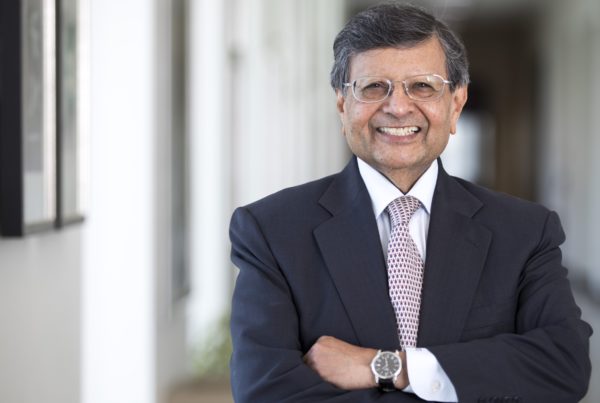Published: Feb 11, 2004 in Knowledge@Emory
Movie mogul Sam Goldwyn once said, “I never make predictions – especially about the future.” When it comes to the outlook for business and the economy, many Emory scholars seem to follow the impresario’s prudent lead. But while most won’t venture a guess about how successful the U.S economy is likely to be this year, they do have some thoughts on what the key elements are likely to be, regardless of whether this year’s show proves a blockbuster or a dud.
For Jagdish Sheth, a professor of marketing at Emory University’s Goizueta Business School and corporate strategist, one enduring trend is likely to be a growing estrangement between the U.S. and the rest of the world. Many countries, even such old allies as South Korea, are beginning to see the U.S. as a country pushing an ideological agenda that has little to do with the global common good, Sheth says. To much of the rest of the world, he says, “we look more and more like a capitalism driven nation in much the same way the Soviet Union was a communism driven nation; it is either our way or the highway.”
Sheth’s thesis, which he says is the subject of an upcoming book, is that the growing economic power of a united Europe and a booming China is behind this changed perception of the U.S. But if politicians are having a hard time getting along these days, businesses don’t seem to have the same problem. In fact, U.S. businesses are working out more international agreements than ever.
Rich Metters, an operations management specialist and professor of decision and information analysis at Goizueta, notes that U.S. firms are now turning to the developing world not just to manufacture goods but also to handle their telephone calls and paperwork. The growth of call centers and outsourcing of back-office operations to India and other developing countries is likely to be an increasingly important issue. Right now, Metters says, the limitation is less lack of capacity in these overseas service bureaus than caution here in the U.S. “What was holding people back from going over there was just a lack of trust. Can they really do it?” he says. But it’s turned out that the Indians and other developing economies really can do it, and now that these arrangements are becoming more familiar, he notes, a growing number of companies will be making this shift.
Many American workers are increasingly upset at the prospect that service jobs are now beginning to follow manufacturing jobs overseas, Metters says. He acknowledges that some laws may be passed against it, but the rules will probably be very limited. His guess: state regulations will require government contractors to hire all domestic service workers, but not much more, as the U.S. is a net beneficiary of this outsourcing.
Of course, every element on the country’s collective balance sheet affects every other element. In this case, the sum of purchases of cheaper goods and services apparently contributed to substantial declines in the 2003 dollar, since the U.S. as a whole imported about $500 billion more than it exported. For smaller countries, consistent imbalances between the money flowing out and money coming in usually lead to a currency crisis sooner or later. But what about a larger country like the U.S.?
Emory macroeconomist Zheng Liu says that he doesn’t believe the dollar will undergo a crisis any time soon. “It’s pretty hard to imagine that a currency crisis will happen. The dollar is such an influential currency. Many international contracts are written in dollars – it’s very common,” Liu observes. “I don’t think people will stop using dollars, at least as a unit of account.”
Liu has his eye on other issues, far away from the headlines. Within the world of macroeconomists, one of the key debates is not about the macroeconomic news at all but about how the show is directed, he says. According to Liu, there is an important debate going on now among macroeconomists between those who think that the Federal Reserve and other countries’ central banks should be governed by rules – for example, by a rule that explicitly limits the amount of inflation permitted – and others who think central banks should be governed by the judgment of the central bank’s directors. Unfortunately for supporters of the idea, the opposition includes an economist named Alan Greenspan.
Greenspan argues that rules could be too restrictive, particularly in times of crisis. “To be sure, sensible policymaking can be accomplished only with the aid of a rigorous analytic structure. A rule does provide a benchmark against which to assess emerging developments. However, any rule capable of encompassing every possible contingency would lose a key aspect of its attractiveness: simplicity,” the Federal Reserve chairman said during his speech to the American Economic Association in San Diego last week, which Liu attended.
Liu disagrees with the Federal Reserve Chairman on whether central banking without any fixed guidelines is a good idea. “I think this is fine if he has good judgment and I believe he does. But if he retires and someone new takes over, if you don’t institutionalize a rules-based approach… and somebody uses bad judgment, then it could be a problem,” he says.
Other Emory economists see a simpler key issue: why the U.S. economy is still not creating any new jobs, despite the apparent recovery. George Benston, a professor of economics, finance, and accounting at Emory and Goizueta, says that one of the key economic questions of the year is why jobs are still not being created. Despite nearly double-digit economic growth in the fall, the economy created only 1,000 additional jobs in December, according to a Bureau of Labor Statistics report – missing economists’ forecasts by a wide 149,000.
One hypothesis he hears: the rising cost of benefits is making U.S. firms behave more like firms in Europe, where high benefits costs have long helped to discourage employers from expanding their payrolls. (Statistics released by the U.S. Department of Health and Human Services in early January showed that for the first time in history health care consumed 14.9% of the U.S. gross domestic product, nearly 5% more of GDP than most of its competitors.) In addition, Benston says, spending on homeland security and the interruptions it provides are also likely to be an economic drag.
Investors on the other hand seem to have already anticipated good economic news. The key question for the stock market this year, observes Goizueta finance professor Narasimhan Jegadeesh, is whether the economy will grow sufficiently to justify the high level of prices?
Surprisingly absent from the professors’ list of issues to watch was the impact of yet more corporate and financial scandals on the economy. Despite the volume of newsprint the scandals generate, professors seemed unconcerned about the scandals’ effect on investor confidence.
The one area where the scandals are clearly having some impact on the economy is in accounting and corporate law – at least in terms of billable hours. William J. Carney, a professor of corporate law at Emory’s School of Law, says that companies are still working to make sure they are in compliance with the Sarbanes-Oxley Act, which was passed in 2002 in the wake of a plague of corporate scandals. “I think people are still in the process [of adapting to the regulations], as near as I can tell,” he says. “It takes a while to fully adjust and protect yourself if things go wrong and surely they’ll go wrong for somebody.”
Carney also believes that new regulations are coming this year for mutual funds, but hopes they won’t be too complex.
Although it might seem as though Wall Street must have finally exhausted itself when it comes to creative chicanery, Carney notes one abuse that’s gone more or less unnoticed by the public: a fairly common stock scam called death-spiral financing.
In death-spiral financing, a fund makes a substantial loan to a small, troubled company that can be converted into shares at any time. The loan is based on the prevailing price of the shares. Once the first installment of the loan is delivered, investors drive the stock price down through short selling, then exercise some of their conversion options to cover their shorts, and just keep doing it until they’ve “driven the price down to the floor,” he says. When the stock hits bottom, the debenture holders convert their position to equity, transforming what has been a small loan into a much larger position.
“I’ve talked to some lawyers who say that what’s going on in some of these cases is these funds are selling short more shares than there are outstanding in this company, ” he notes. Isn’t selling more stocks short than exist illegal? “No, it isn’t” says Carney. “It’s just a naked short in most cases…if the price doesn’t rise you can just keep on short selling as long as no one calls for delivery.”
“I don’t know when that’s all going to come to light in a big time way,” says Carney, “but I think it will, and there will be some changes in the regulatory system about delivery of shares in short transactions.”




